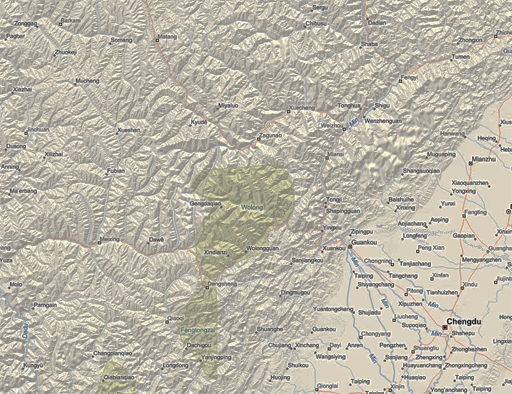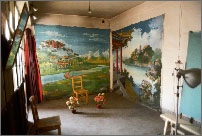May 15, 2008
On the Earthquake

The city of Wenchuan where the recent earthquake in China was centered lies only a few miles away from the Longmenshan fault. The fault severs Sichuan province on the diagonal cutting it roughly in half. From ground the land to the east of the fault appears flat, but if you fly above it, you will see the earth slopes down into a huge basin (geologists call this the Sichuan Basin). On the other side of the fault, to the west, the land immediately deforms and flatlands quickly become foothills and foothills abruptly become an imposing labyrinth of impossibly high mountains and deep river valleys.
Until about 40 years ago the city of Wenchuan was one of the last major Chinese outposts before getting into the serious mountains. It’s lies at 4347 feet above sea level. Respectable, but a drive up the road you start hitting passes that are at 15,000 feet, then 17,000 feet...a day up the road you hit a 19,000 foot pass and those are the passes, the low spots between the mountains. The landscape is beyond human scale. For hundreds of years this was were where China effectively ended. Beyond were various kingdoms and fiefdoms of tribal peoples such as the Miao, the Naxi, the Qiang, the Yi, the Lisu and the many tribes of people we now group under the title Tibetans. Chinese mythology is full of stories of the mountains being the home to demons and spirits and in many old Chinese maps these mountains and the imposing deserts to the north of them represent the ends of the earth. The people in the mountains spoke foreign languages, practiced a foreign religion, and were ethnically distinct from the Chinese.
Mao Zedong made a conscious decision to take control of Sichuan's mountains, as well as Tibet’s 3 primary kingdoms. This area represented to him, and to the majority of Chinese today, part of that country's manifest destiny. Mao's government sent tens of thousands of Chinese up into the highlands as part of an organized "education and cultural assimilation" campaign both to teach city people the value of manual labor and to bring Chinese culture to the region. Local culture was systematically destroyed, monasteries were blown up, local religion and language were banned, and small villages were turned into Chinese cities. Living standards for many improved, but at the cost of their cultural heritage. Instead of small self sustaining organic communities living in symbiosis with the land the Chinese built medium sized cities often on grids, they dammed the rivers and relied almost exclusively on imports from hundreds of miles away to feed and cloth the people of those cities. Today there is hardly a city in the region without a majority Chinese population and in most cities vernacular architecture and customs are rapidly being erased.
As the land in these areas is so steep and harsh, most cities lie in deep river valleys. Because flat land is at a premium cities are often spread out over the thin strip of land on both sides of river bottoms. There are hundreds of rivers as this is China’s watershed and up every river and tributary you will often find a town or two. For the most part, dams have tamed these rivers providing power and most cities are connected by roads to the outside world. But these are tenuous connections. Most cities often only have a single road that passes through and connections to other cities and the outside world have to pass through some of the most rugged landscape in the world. Still, bit by bit, the Chinese have tried to take control of the landscape. Twenty years ago a bus ride to Wenchuan from the mega-city of Chengdu was a 14 hour ordeal. Today there are major highways with many tunnels cutting through mountains and the trip only takes about 3 hours or at least it did before the earthquake struck.
Beyond Wenchuan the mountain roads get narrower and even in the best of times have to be cleared regularly of debris from almost daily rockslides and washouts. Virtually all of western Sichuan as well as the provinces further north and west were recently closed due to riots. The riots in which ethnic Tibetans revolted against Chinese authorities and Chinese setters were the result of years marginalization, a kind of soft apartheid in which non-Chinese speaking locals are inexorably losing control of their historical homeland. The protests (and the crackdown in response) have been going on for months now in an area twice the size of Texas which has been almost completely cut off from reporters and travelers (Nicholas Kristoff managed to get in a rare report from the region in today’s NY TImes) The largest roads into this area run through Sichuan and right now apparently those roads are closed which makes the isolation even more complete. In addition to destroying roads homes and schools, the earthquake damaged hundreds of tunnels, bridges, and dams.
Looking at the images coming out of China I’m of course horrified by the destruction and loss of life wrought by the earthquake, in fact I worry that the actual death toll is much much higher than officially reported. The mountains are full of small towns and in village after village local Chinese governments have had habit of bulldozing indigenous architecture and erecting Chinese style concrete apartment buildings. While sometimes the buildings will have a locally inspired fillip as a nod to the tourists they tend to essentially be cheap concrete boxes, constructed fast and dirty. Judging from the pictures of the disaster it is these structures which have failed so dramatically turning entire cities into rubble. Many of those cities will be totally cut of for some time. Traditional villages in this area were even 15 years ago much smaller, one story affairs often built of wood and less susceptible to catastrophe than concrete apartment blocks perched on steep mountain ledges and at the bottom of deep river canyons.
My suspicion and fear is that the government will use the the world’s sympathy for the quake victims and rightful admiration for the heroics of the People’s Liberation Army whose soldiers working under the worst of conditions to detract from the harsh crackdown on Tibetans in the region. I suspect it will take years to find out what has really happened inland from to epicenter to tribal communities devastated by this this quake. My hope is that the quake will give the government in Beijing pause about overdevelopment in a region so inherently fragile where life has always been tenuous. Perhaps they will even take lessons from the indigenous people who have managed to live in harmony with this harsh environment for centuries rather than taking on the Sisyphean task of rebuilding and controlling the uncontrollable.



05/16/08 03:11 AM
Nancy said...
Interesting comments, Raul. We are also following this closely. You might be interested to watch the news about it on BBC Newsnight which you can see on the internet.
05/16/08 07:22 PM
olivier said...
Actually, I am of the mind that this might very well loosen China's grip on that part of the world quite considerably. Remember the 天命(Tianming)?
05/18/08 09:43 AM
Kris said...
You people are sick. Politics, always politics. If you really care about the people living there, quit babbling about the politics in your living room and donate to your local Red Cross.
05/18/08 12:26 PM
raul said...
Your money will be better spent donating to the main Chinese aide organization providing aide in the region (the Chinese government allows the Red Cross almost no direct access to the disaster area): http://www.chinadaily.com.cn/html/special/earthquake/earthquake-2.htm
By ignoring the politics of the situation you are ignoring the realities that have helped put millions of people in shoddily constructed buildings in an inherently dangerous area. And that's not even getting into the environmental and cultural disasters that have already taken place by overdevelopment or the local politics that allowed so many substandard schools to be built. Ignore the politics and you are living with your head in the sand.
05/18/08 05:31 PM
Andrew Gold said...
I find it telling that the official media is recounting the stories of ethnic Chinese people (both victims and rescuers) when much of the area in the earthquake zone has large Qiang and Tibetan populations. While I've read hundreds of news stories about the disaster the only official media report I've seen mentioning a Tibetan is this one: http://www.chinadaily.com.cn/china/2008-05/15/content_6688621_2.htm but of course it was on an English Language website (I worked in this area and upper Yunnan for 9 years my Chinese is passable, but I've seen not a single Chinese language report mentioning Tibetans although some Tibetan friends who have retreated back to Litang say that tens of thousands if not hundreds of thousands of Tibetans were affected. As you say only time will reveal the full extent of this tragedy. This area was closed off before the quake for political reasons...one wonders what's happening now that nature has further isolated them.
One hopes that the instead of trying to rebuild government will see that continuing to build large concrete block cities on the bottom of steep canyons in one of the world's worst earthquake zones would be another tragedy.
05/22/08 01:28 PM
Hu said...
Over 7000 schools collapsed. Often next to other government buildings which did not collapse, if that isn't the result of politics, I don't know what is.
...
Some earthquake photos that capture the horror of the thing: http://www.xanga.com/lelandwong/657607591/photographing-a-wedding-and-then-an-earthquake.html